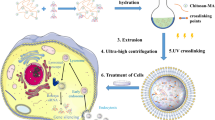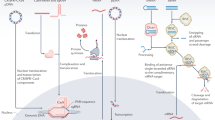Abstract
Vaginal instillation of small-interfering RNA (siRNA) using liposomes has led to silencing of endogenous genes in the genital tract and protection against challenge from infectious disease. Although siRNA lipoplexes are easily formulated, several of the most effective transfection agents available commercially may be toxic to the mucosal epithelia and none are able to provide controlled or sustained release. Here, we demonstrate an alternative approach using nanoparticles composed entirely of FDA-approved materials. To render these materials effective for gene silencing, we developed novel approaches to load them with high amounts of siRNA. A single dose of siRNA-loaded nanoparticles to the mouse female reproductive tract caused efficient and sustained gene silencing. Knockdown of gene expression was observed proximal (in the vaginal lumen) and distal (in the uterine horns) to the site of topical delivery. In addition, nanoparticles penetrated deep into the epithelial tissue. This is the first report demonstrating that biodegradable polymer nanoparticles are effective delivery vehicles for siRNA to the vaginal mucosa.
This is a preview of subscription content, access via your institution
Access options
Subscribe to this journal
Receive 12 print issues and online access
$259.00 per year
only $21.58 per issue
Buy this article
- Purchase on Springer Link
- Instant access to full article PDF
Prices may be subject to local taxes which are calculated during checkout






Similar content being viewed by others
References
Grant, R. M. et al. Perspective—whither or wither microbicides? Science 321, 532–534 (2008).
Wilson, D. P., Coplan, P. M., Wainberg, M. A. & Blower, S. M. The paradoxical effects of using antiretroviral-based microbicides to control HIV epidemics. Proc. Natl Acad. Sci. USA 105, 9835–9840 (2008).
Veazey, R. S. et al. Protection of macaques from vaginal SHIV challenge by vaginally delivered inhibitors of virus-cell fusion. Nature 438, 99–102 (2005).
Richardson, J. L. & Illum, L. Penetration enhancement for polypeptides through epithelia. D. Routes of delivery case studies. 8. The vaginal route of peptide and protein drug delivery. Adv. Drug. Delivery Rev. 8, 341–366 (1992).
Veazey, R. S. et al. Prevention of virus transmission to macaque monkeys by a vaginally applied monoclonal antibody to HIV-1 gp120. Nature Med. 9, 343–346 (2003).
Sherwood, J. K., Zeitlin, L., Whaley, K. J., Cone, R. A. & Saltzman, M. Controlled release of antibodies for long-term topical passive immunoprotection of female mice against genital herpes. Nature Biotechnol. 14, 468–471 (1996).
Shen, H., Goldberg, E. & Saltzman, W. M. Gene expression and mucosal immune responses after vaginal DNA immunization in mice using a controlled delivery matrix. J. Control. Release 86, 339–348 (2003).
Palliser, D. et al. An siRNA-based microbicide protects mice from lethal herpes simplex virus 2 infection. Nature 439, 89–94 (2006).
Gu, W. et al. Inhibition of cervical cancer cell growth in vitro and in vivo with lentiviral-vector delivered short hairpin RNA targeting human papillomavirus E6 and E7 oncogenes. Cancer Gene Ther. 13, 1023–1032 (2006).
Kumar, P. et al. T cell-specific siRNA delivery suppresses HIV-1 infection in humanized mice. Cell 134, 577–586 (2008).
Stone, A. Microbicides: A new approach to preventing HIV and other sexually transmitted infections. Nature Rev. Drug Discov. 1, 977–985 (2002).
Morrissey, D. V. et al. Potent and persistent in vivo anti-HBV activity of chemically modified siRNAs. Nature Biotechnol. 23, 1002–1007 (2005).
Zimmermann, T. S. et al. RNAi-mediated gene silencing in non-human primates. Nature 441, 111–114 (2006).
Sato, Y. et al. Resolution of liver cirrhosis using vitamin A-coupled liposomes to deliver siRNA against a collagen-specific chaperone. Nature Biotechnol. 26, 431–442 (2008).
Hannon, G. J. & Rossi, J. J. Unlocking the potential of the human genome with RNA interference. Nature 431, 371–378 (2004).
Breunig, M., Lungwitz, U., Liebl, R. & Goepferich, A. Breaking up the correlation between efficacy and toxicity for nonviral gene delivery. Proc. Natl Acad. Sci. USA 104, 14454–14459 (2007).
Lv, H. T., Zhang, S. B., Wang, B., Cui, S. H. & Yan, J. Toxicity of cationic lipids and cationic polymers in gene delivery. J. Control. Release 114, 100–109 (2006).
Li, S., Rizzo, M. A., Bhattacharya, S. & Huang, L. Characterization of cationic lipid-protamine-DNA (LPD) complexes for intravenous gene delivery. Gene Ther. 5, 930–937 (1998).
Zhang, J. S., Liu, F. & Huang, L. Implications of pharmacokinetic behavior of lipoplex for its inflammatory toxicity. Adv. Drug Delivery Rev. 57, 689–698 (2005).
Conwell, C. C., Liu, F. & Huang, L. Several serum proteins significantly decrease inflammatory response to lipid-based non-viral vectors. Mol. Ther. 16, 370–377 (2008).
Khazanov, E., Simberg, D. & Barenholz, Y. Lipoplexes prepared from cationic liposomes and mammalian DNA induce CpG-independent, direct cytotoxic effects in cell cultures and in mice. J. Gene Med. 8, 998–1007 (2006).
Peer, D., Park, E. J., Morishita, Y., Carman, C. V. & Shimaoka, M. Systemic leukocyte-directed siRNA delivery revealing cyclin D1 as an anti-inflammatory target. Science 319, 627–630 (2008).
Panyam, J. & Labhasetwar, V. Dynamics of endocytosis and exocytosis of poly(D,L-lactide-co-glycolide) nanoparticles in vascular smooth muscle cells. Pharm. Res. 20, 212–220 (2003).
Panyam, J., Zhou, W. Z., Prabha, S., Sahoo, S. K. & Labhasetwar, V. Rapid endo-lysosomal escape of poly(DL-lactide-co-glycolide) nanoparticles: Implications for drug and gene delivery. FASEB J. 16, 1217–1226 (2002).
Farokhzad, O. C. et al. Targeted nanoparticle-aptamer bioconjugates for cancer chemotherapy in vivo. Proc. Natl Acad. Sci. USA 103, 6315–6320 (2006).
Murata, N., Takashima, Y., Toyoshima, K., Yamamoto, M. & Okada, H. Anti-tumor effects of anti-VEGF siRNA encapsulated with PLGA microspheres in mice. J. Control. Release 126, 246–254 (2008).
Khan, A. et al. Sustained polymeric delivery of gene silencing antisense ODNs, siRNA, DNAzymes and ribozymes: In vitro and in vivo studies. J. Drug Target 12, 393–404 (2004).
Bachrach, U. Naturally occurring polyamines: Interaction with macromolecules. Curr. Protein Pept. Sci. 6, 559–566 (2005).
Childs, A. C., Mehta, D. J. & Gerner, E. W. Polyamine-dependent gene expression. Cell. Mol. Life Sci. 60, 1394–1406 (2003).
Freiberg, S. & Zhu, X. Polymer microspheres for controlled drug release. Int. J. Pharm. 282, 1–18 (2004).
Grayson, A. C. R., Doody, A. M. & Putnam, D. Biophysical and structural characterization of polyethylenimine-mediated siRNA delivery in vitro. Pharm. Res. 23, 1868–1876 (2006).
Robbins, M. et al. Misinterpreting the therapeutic effects of small interfering RNA caused by immune stimulation. Hum. Gene Ther. 19, 991–999 (2008).
Flynn, M., Casey, D., Todryk, S. & Mahon, B. Efficient delivery of small interfering RNA for inhibition of IL-12p40 expression in vivo. J. Inflamm. 1, 1–12 (2004).
Song, E. W. et al. Antibody mediated in vivo delivery of small interfering RNAs via cell-surface receptors. Nature Biotechnol. 23, 709–717 (2005).
Zender, L. et al. Caspase 8 small interfering RNA prevents acute liver failure in mice. Proc. Natl Acad. Sci. USA 100, 7797–7802 (2003).
Robbins, M. et al. Misinterpreting the therapeutic effects of small interfering RNA caused by immune stimulation. Hum. Gene Ther. 19, 991–999 (2008).
Zhang, S. B., Zhao, B., Jiang, H. M., Wang, B. & Ma, B. C. Cationic lipids and polymers mediated vectors for delivery of siRNA. J. Control. Release 123, 1–10 (2007).
Castanotto, D. & Rossi, J. J. The promises and pitfalls of RNA-interference-based therapeutics. Nature 457, 426–433 (2009).
Whitehead, K. A., Langer, R. & Anderson, D. G. Knocking down barriers: Advances in siRNA delivery. Nature Rev. Drug Discov. 8, 129–138 (2009).
Park, T. G., Jeong, J. H. & Kim, S. W. Current status of polymeric gene delivery systems. Adv. Drug Delivery Rev. 58, 467–486 (2006).
Jiang, W. L., Gupta, R. K., Deshpande, M. C. & Schwendeman, S. P. Biodegradable poly(lactic-co-glycolic acid) microparticles for injectable delivery of vaccine antigens. Adv. Drug Delivery Rev. 57, 391–410 (2005).
Putney, S. D. & Burke, P. A. Improving protein therapeutics with sustained-release formulations. Nature Biotechnol. 16, 153–157 (1998).
Yuan, X. D. et al. siRNA drug delivery by biodegradable polymeric nanoparticles. J. Nanosci. Nanotechnol. 6, 2821–2828 (2006).
Braden, A., Kashyap, A., Vasir, J., Labhasetwar, V. & Vishwanatha, J. K. Polymeric nanoparticles for sustained down-regulation of annexin A2 lead to reduction in proliferation and migration of prostate cancer cells. J. Biomed. Nanotechnol. 3, 148–159 (2007).
Conner, S. D. & Schmid, S. L. Regulated portals of entry into the cell. Nature 422, 37–44 (2003).
Thomas, T. & Thomas, T. J. Polyamines in cell growth and cell death: Molecular mechanisms and therapeutic applications. Cell. Mol. Life Sci. 58, 244–258 (2001).
Olmsted, S. S. et al. Diffusion of macromolecules and virus-like particles in human cervical mucus. Biophys. J. 81, 1930–1937 (2001).
Lai, S. K. et al. Rapid transport of large polymeric nanoparticles in fresh undiluted human mucus. Proc. Natl Acad. Sci. USA 104, 1482–1487 (2007).
Novina, C. D. et al. siRNA-directed inhibition of HIV-1 infection. Nature Med. 8, 681–686 (2002).
Acknowledgements
We are grateful to R. Flavell for use of the IVIS 200 imaging system. We are also grateful to A. Haberman and D. Gonzalez for assistance with the two-photon microscopy imaging. We thank T. Kyriakides, A. Iwasaki and S. Jay for helpful analysis and discussion of tissue sections used for immunohistochemistry. We also thank A. Sin for assistance with nanoparticle characterization and J. Blum for technical assistance with the animal experiments. Y. Cu, J. Saucier-Sawyer, A. Lin and J. Blum carried out blind scoring of the microscopy images for fluorescence. This work was supported by grants from the NIH to W.M.S. (RO1-EB0000487-18). K.A.W. acknowledges the fellowship support from the L’Oreal FWIS and a postdoctoral training fellowship (T32-HL007950-08).
Author information
Authors and Affiliations
Contributions
K.A.W. and W.M.S. designed the experiments. K.A.W. prepared and characterized the siRNA polymer nanoparticles. K.A.W., J.K.S.S. and M.J.W. carried out the in vitro cell culture experiments, and also collected and analysed the data. K.A.W. and J.K.S.S. carried out the in vivo animal experiments and collected the reproductive tissue, and K.A.W carried out the tissue sectioning, and the collection and analysis of microscopy images. K.A.W. and Y.C. prepared fluorescent nanoparticles and carried out biodistribution studies, and Y.C. collected and analysed data from these studies. K.A.W. carried out the immunohistochemical staining and C.J.B. carried out the histological examination of sectioned tissues.
Corresponding author
Supplementary information
Supplementary Information
Supplementary Information (PDF 1569 kb)
Rights and permissions
About this article
Cite this article
Woodrow, K., Cu, Y., Booth, C. et al. Intravaginal gene silencing using biodegradable polymer nanoparticles densely loaded with small-interfering RNA. Nature Mater 8, 526–533 (2009). https://doi.org/10.1038/nmat2444
Received:
Accepted:
Published:
Issue Date:
DOI: https://doi.org/10.1038/nmat2444
This article is cited by
-
A review on the nanotechnology-based approaches for managing sexually transmitted infections
Journal of Pharmaceutical Investigation (2024)
-
Fused deposition modeling three-dimensional printing of flexible polyurethane intravaginal rings with controlled tunable release profiles for multiple active drugs
Drug Delivery and Translational Research (2022)
-
Smart nanocarriers as therapeutic platforms for bladder cancer
Nano Research (2022)
-
Extension in the approaches to treat cancer through siRNA system: a beacon of hope in cancer therapy
Drug Delivery and Translational Research (2022)
-
MicroRNA-155 contributes to plexiform neurofibroma growth downstream of MEK
Oncogene (2021)



